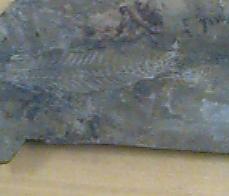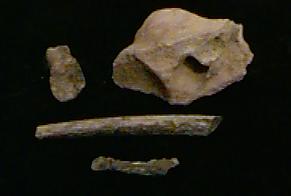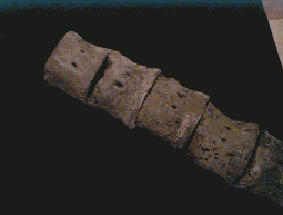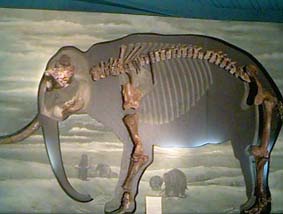General information | History of the museum | Our services | Exposition | Collections
FAUNA
STEGOCEPHALI IMPRINT
Kaskelen district, Almaty region.
 Unique item of palaeozoological
collection is imprint on the schist of invertebrate animal - Trilobita, lived 420 mln
years ago. One of the most interesting articles of ancient vertebrates is
Stegocephali's imprint, dated about 300 mln years. Stegocephali are known from
Devonian period, warm and damp climate of Carbonian era was favourable for all organisms,
and Carbonian was the period of their prime. Changing of living conditions at the end of
Carbonian period caused their extinction and origin of primitive reptiles from Testaceous
amphibias. Stegocephali disappeared in Late Jura.
Unique item of palaeozoological
collection is imprint on the schist of invertebrate animal - Trilobita, lived 420 mln
years ago. One of the most interesting articles of ancient vertebrates is
Stegocephali's imprint, dated about 300 mln years. Stegocephali are known from
Devonian period, warm and damp climate of Carbonian era was favourable for all organisms,
and Carbonian was the period of their prime. Changing of living conditions at the end of
Carbonian period caused their extinction and origin of primitive reptiles from Testaceous
amphibias. Stegocephali disappeared in Late Jura.
GADROSARIDAE
Kzyl-Orda region.
 Collection of osteological remains of
pangolins of Mesozoic era presents Gadrosaridae, lived 140 mln years ago. These
gigantic herbivorous pangolins have got their name owing to similarity of their muzzle
with duck's beak.
Collection of osteological remains of
pangolins of Mesozoic era presents Gadrosaridae, lived 140 mln years ago. These
gigantic herbivorous pangolins have got their name owing to similarity of their muzzle
with duck's beak.
Body length is 15 metres, it's height - 9 metres. The basic peculiarity of
Gadrosaridae was crest on the skull, formed of nose bones.
Gadrosaridae osteological remains (80 mln years ago) were discovered in the Southern
Kazakhstan.
PLESIOSAURIA
 Kostanai region.
Kostanai region.
Plesiosauria - sea pangolins with little head on a long neck. The largest was
Elasmosauridae, it's length was 13 metres. The neck consisted of 76 vertebraes and was the
longest during all Earth history.
Plesiosauria lived in Jurassic Period and extincted at the end of Cretaceous era.
MAMMUNTHUS -
(Mammunthus primigenius Blumenbach, 1799 ã.)

Osteological remains of Mammunthtus - representative of 5 species of probo-
scises, inhabited the territory of Kazkhstan and extincted 10-12 thousand years ago, were
spread everywhere. They lived in northern areas of Eurasia in Pleistocene epoch. The
largest were of 3,5-4 metres heiht and weigs about 6 tons. They had a
long (80 cm) and thick yellow-brown hair which protected animal from severe climate
of the Ice-age.
Mammunthus inhabited river valleys, lake and swamp banks with rich and various vegetation.